What is a gaiwan?
A gaiwan (or "guywan" with Wade-Giles romanization) is actually a pretty simple little contraption. It consists of just three parts, as shown here: the lid (left), the cup (center), and the saucer (right). It can be made from pretty much anything except metal (which would absorb far too much heat), such as glass, porcelain, or clay.
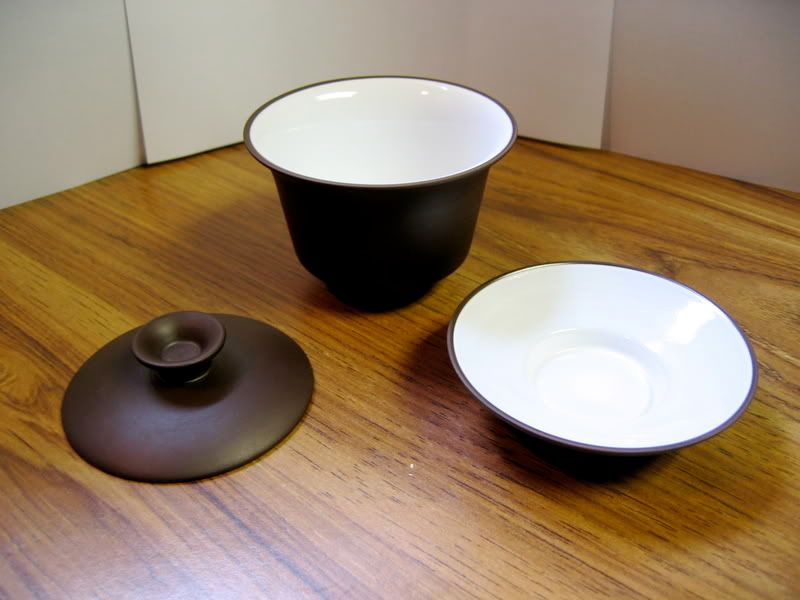 There are no bells and whistles here-- a gaiwan is essentially the same as any standard European teacup, except that it has a lid and no handle. Though the gaiwan can be used as a cup, it is more importantly used to brew the tea itself, replacing the teapot. One can, as I just mentioned, drink straight from the gaiwan, or one can decant the liquor into another cup or serving pitcher (not shown).
There are no bells and whistles here-- a gaiwan is essentially the same as any standard European teacup, except that it has a lid and no handle. Though the gaiwan can be used as a cup, it is more importantly used to brew the tea itself, replacing the teapot. One can, as I just mentioned, drink straight from the gaiwan, or one can decant the liquor into another cup or serving pitcher (not shown).Why should I use a gaiwan?
Most Americans have never seen or heard of a gaiwan. Here in the states, we are far more familiar with 10-cup teapots and 8+ oz coffee mugs, or other large scale tea preparation tools. In contrast, the threshold volume at which a gaiwan is considered large is about 4 oz. In my opinion, tea is best enjoyed in small quantities, so the gaiwan is a perfect tool for making good tea.
As any cook can tell you, recipes just don't turn out the same when preparing for twenty people versus only two. Subleties can be lost, and often the recipe will need major changes in its ingredients to bring out the right flavors.
 Unfortunately, when working with tea, the only ingredients we can change are leaves and water. We can't just add another teaspoon of a subtle fruity flavor or a pinch of citrus notes (well, we can with flavorings, but I'm talking about unflavored teas here) to make large quantities of tea taste right. This means that a tea's true flavors and aromas really only come out when it is made in small batches.
Unfortunately, when working with tea, the only ingredients we can change are leaves and water. We can't just add another teaspoon of a subtle fruity flavor or a pinch of citrus notes (well, we can with flavorings, but I'm talking about unflavored teas here) to make large quantities of tea taste right. This means that a tea's true flavors and aromas really only come out when it is made in small batches.The other great thing about gaiwans is that you can use them for basically anything. The only things that I see potential problems with are Japanese greens and rooibos-- these leaves are so small that it may be difficult to decant the liquid without letting quite a few of them through. Brewing black teas may also pose a problem, as it requires working with very hot water, but it can be done.
How do I use a gaiwan?
It was a bit daunting to use a gaiwan the first time I tried. To be honest, I'm still not quite sure I'm doing everything right. Nevertheless, I have put together a little guide (emphasis on little) for other beginners. Note that amount of leaf, water temperature, washing techniques, etc. will vary from tea to tea as well as person to person, so I won't even try to get into that here. For a good summary, check out Chinese Teas 101.
When I started using a gaiwan, the hardest part was figuring out how to hold and pour the darn thing properly. I read on some website (I can't remember where, sorry) that you were supposed to hold the gaiwan cup around its rim with your thumb and middle fingers, and then hold back the lid/tilt the apparatus with your middle finger. This led to some catastrophic failures-- tea all over the place, half of the leaves in my drinking cup, burnt fingers-- so I searched around some more. Taking strategies from both online sources (such as Chinese Teas 101's large gaiwan handling guide) and my own limited experience, I eventually found a fairly easy technique that also eliminated the risk of bodily injury/disfigurement. (Okay, disfigurement may be a bit over the top, but I couldn't resist.) So, without further ado, I give you my four step method to success.
Many stores sell wooden or ceramic tea trays for you to do your gaiwan brewing on. While I could see how they would be convenient, I hardly consider this a necessity (I don't have one). Still, I would suggest staying far, far away from expensive electronics while you work out the kinks in your technique.
Wrap up
Gaiwans are extremely versatile, and quite good at what they do. While they may not be as good as yixing pots for many Chinese teas, you do not need to worry about brewing vastly different types of tea with a glazed gaiwan. The best part? They're cheap, and they're all over the internet.
The one shown in this article is from ebay, and was only $8.00! I actually paid more ($8.50) for the shipping from China than for the actual item. $16.50 is pretty hard to beat as far as teaware is concerned, and I'm sure there are even cheaper gaiwans out there. The only thing to be aware of is that glazes in cheap Chinese ceramics may contain lead, but a lead testing kit can be purchased quite inexpensively from your local hardware store.
Now, go forth and brew!

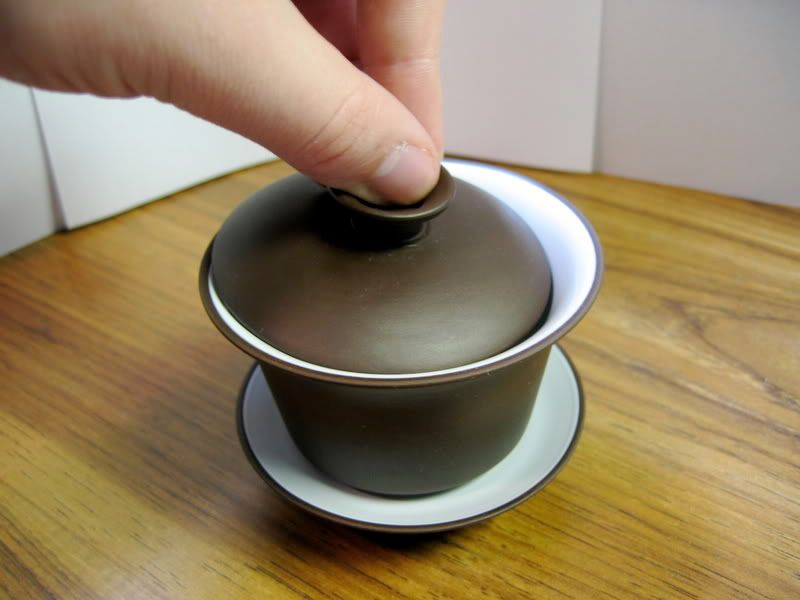
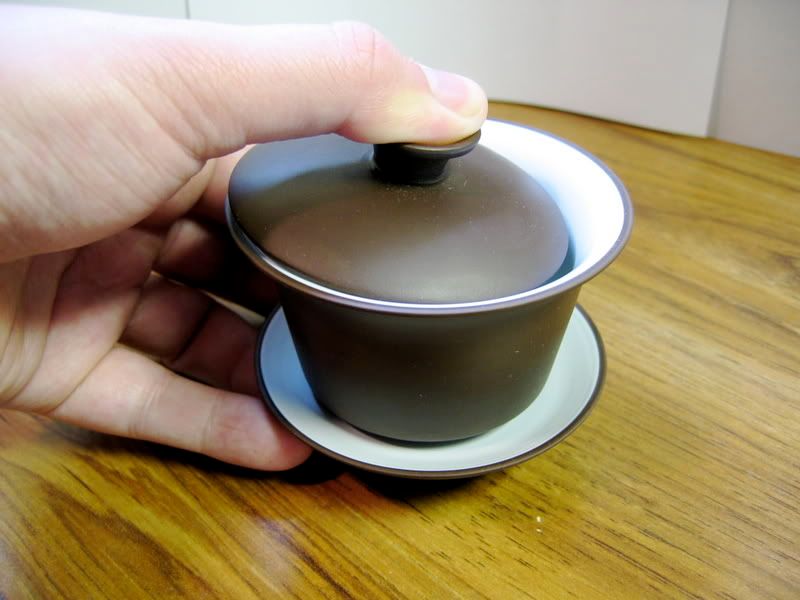
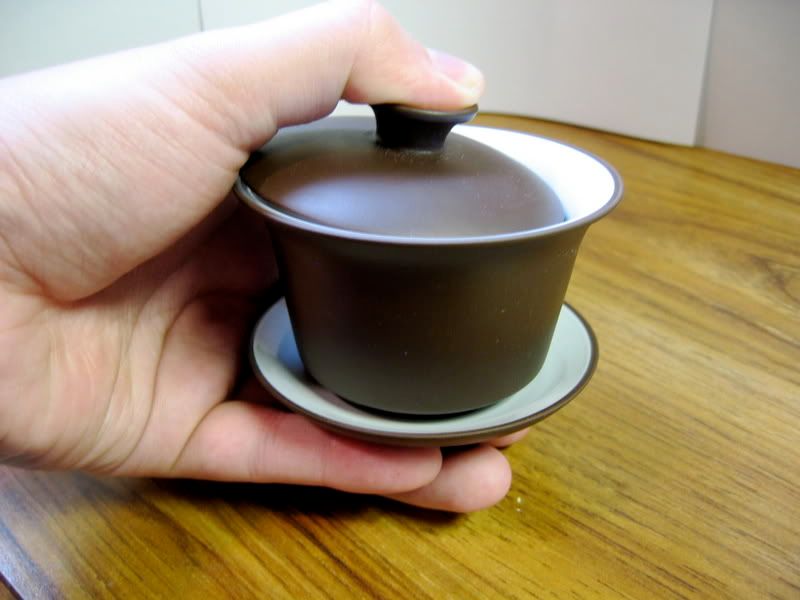
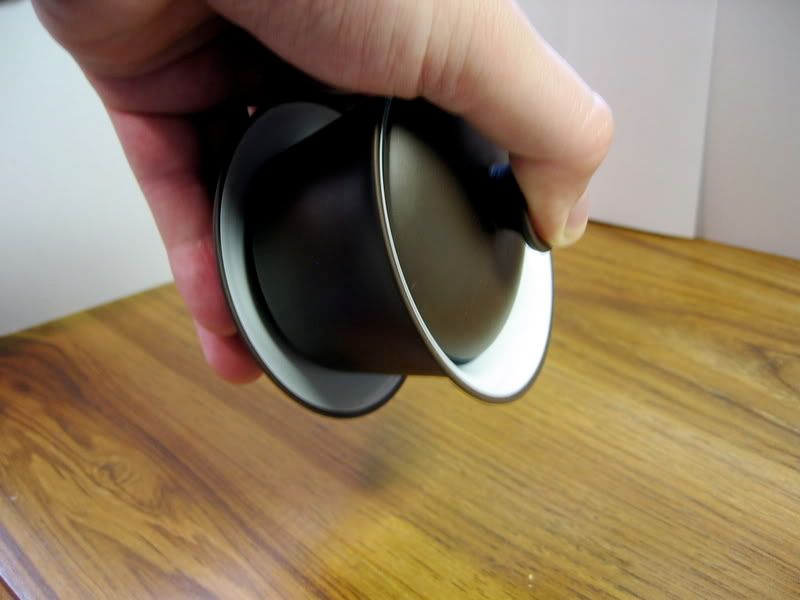

Burninating the village, burninating the countryside...
ReplyDeleteIt was so great to read this post today. Andy, Salsero and I were doing some hardcore gaiwan shopping earlier. I've been trying to find something a bit less 'eggshell' than the gaiwan I have now. I'm in break-a-palooza mode.
This does look like an easier method than my current catastrophic fumblings. I'm going to have to do a few dry runs over a very soft surface, though--I'm such a klutz! Love the pictures!
Yo! Hey, I was right about Hop ordering tea from eBay's Dragon Tea House. He highly recommends them, actually. He says that while things come on the slow boat from China, everything arrives in great condition and they always include a sample of something. He compared it to Puerh Shop (based in Indy, of all places), which he said sometimes sends things with a torn wrapper and no samples, etc. He attributes that to the shipping they choose from China. I'm pretty sure they use Fed Ex to ship domestically.
ReplyDeleteI love gaiwans. I generally only use them however, when I am testing a tea or for my greens since I have dedicated all of my yixing to pu-erh. Cool post. PERFECT INNSTRUCTION!
ReplyDeleteLooking at these photos almost a year later, I'll bet photo 4 is not how you hold your gaiwan when it is full of hot tea, that is, with your palm upwind of the steam. If you do it the way I do, your palm is on the side of the gaiwan to avoid the heat.
ReplyDeleteDo you think wikiCHA should have another link under yours in the gaiwan section, a link to Kam's very clear illustration of the alternate method of holding the gaiwan? http://chineseteas101.com/gaiwan.htm. I remember enjoying his humor when I first tried to learn.
I lived in Ningxia, Dawokou China for a year, and I have never heard of using a Gaiwan in the way its explained in this site. Maybe its a Japanese or a different asian country's way of using the Gaiwan, but in China everyone uses the Gaiwan as an everyday tea cup.
ReplyDeleteIt took me awhile to learn how to hold the lid just right so that I could sip out of the tea cup without getting a mouthful of leaves. One of the reasons in China that they use this type of tea cup called the Gaiwan is because many of the teas are packaged individualized portions of large flowers, fruits, berries, dried leaves, and sugar cubes. Perfectly measured for the great tasting tea (very hard to find in the usa). Such teas are referred to as Ba Bau Cha in Chinese (Eight Treasure Tea).
Hi.
ReplyDeleteI just read a post about gaiwan etiquette in China. Some of this I learned from being there, such as to signal one needs more water, one sits the lid upside down or to indicate to a waiter to bring the bill, one should place the lid on the cup of their gaiwan in an inverted manner; but I wondered if you might have more information on such things. I am always interested in furthering my tea knowledge, so that you for this blog - it is exceedingly helpful!
Micha,
ReplyDeleteInteresting, thanks for sharing. I can't say I know anything more about gaiwan etiquette though, sorry!
Brent
Hey, you have the exact same gaiwan as me! Did you get yours from Teaopia as well?
ReplyDeleteBy the way, it's easier and safer to pour it without holding the saucer, I find. Fingers should be on the bottom of the gaiwan and on the lid, with minimal contact to the hot sides.
Besides, really, it is tea, which is a hot beverage, so getting burned is to be expected when unfamiliar with how to work with it and its various accessories.
Enjoyable post, wit appreciated. Like the dragons of the Shaolin monk, burn marks on the thumb and first two fingers will alert the wizened cha-lover to the presence of a fellow teamaster.
ReplyDeleteWhere did you get yours? It looks cool!
ReplyDeleteAsiatic Fox, I have the same gaiwan as well. From Teaopia. Mine has cracked up on the inside quite badly (it bubbles when water is added now). Has anyone else had a similar problem with this cup?
ReplyDelete